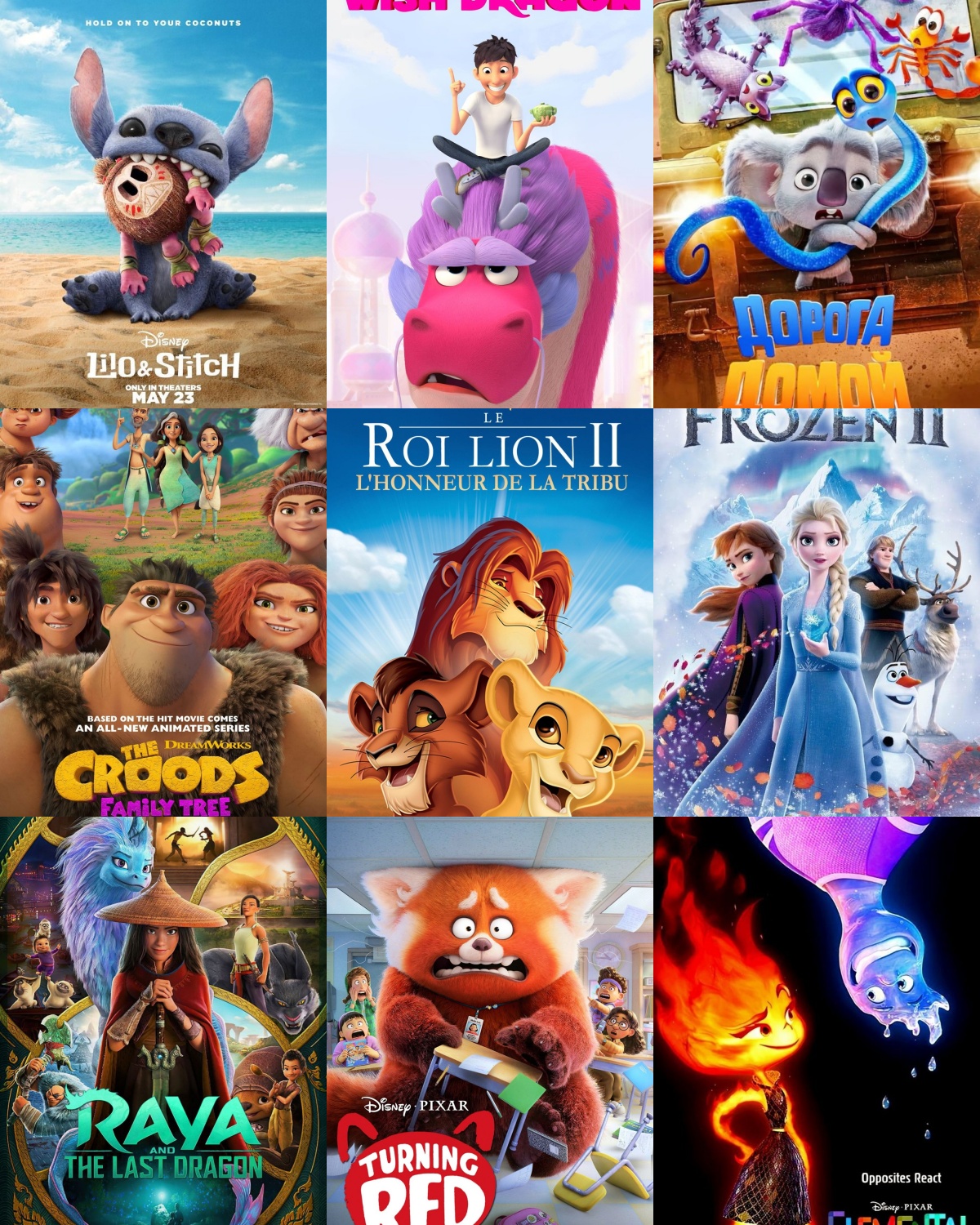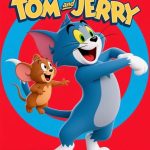From Up to Zootopia: Animated Films You Can’t Miss

Related Movies:
Related Movies:
Related Movies:
Related Movies:
Related Movies:
Related Movies:
Related Movies:
Lilo & Stitch 2 (2025):
Lilo & Stitch 2 (2025) is an exciting and heartwarming sequel that revisits the beloved characters from the original Lilo & Stitch film. Set a few years after the first movie, the story follows Lilo and Stitch as they continue to navigate their unusual yet deep friendship and the challenges of growing up. Lilo, now a little older, is faced with new obstacles that test her relationship with Stitch and her sense of identity, while Stitch, still as mischievous as ever, learns important lessons about loyalty and family.
The sequel delves deeper into Lilo’s personal growth, highlighting her desire to belong and make her family proud, especially as she deals with the pressures of being a young girl in a world that’s still so new to her. When an old experiment from Dr. Jumba’s past is accidentally released, Lilo and Stitch are thrust into another adventure, working together to track down the rogue experiment and save their island home.
The emotional core of Lilo & Stitch 2 remains its heartwarming depiction of family, and this time, the film focuses not only on Lilo’s bond with Stitch but also on the importance of their extended ‘ohana (family), including Nani, their caretaker, and their neighbors, who all come together to support one another. The themes of love, loyalty, and belonging resonate deeply, making the film a touching reminder of what family truly means.
The animation style retains the charm of the original, with vibrant colors, playful designs, and expressive character animation that brings the quirky characters and lush Hawaiian landscapes to life. The film balances lighthearted fun with more emotional moments, ensuring that both children and adults will find something to enjoy. The action sequences involving Stitch and his trademark chaos are exciting and full of humor, while quieter moments between Lilo and Stitch offer real emotional depth.
The voice cast, led by the return of the iconic voices of Lilo and Stitch (voiced by Daveigh Chase and Chris Sanders), provides the same warmth and authenticity that made the original so beloved. The returning characters, including Nani and Jumba, are just as lovable and bring an added layer of humor and family dynamic to the story.
The soundtrack continues the tradition of the original, featuring Hawaiian-inspired tunes and original songs that capture the spirit of aloha. The music serves as a perfect backdrop to the story, adding to the island atmosphere and reinforcing the film’s themes of love and unity.
Lilo & Stitch 2 (2025) is a delightful and emotionally resonant sequel that stays true to the heart and spirit of the original film. With its beautiful animation, memorable characters, and touching message about family and belonging, it is a perfect continuation of Lilo and Stitch’s story. It reminds us that no matter where we come from or how different we are, family is about love, acceptance, and being there for one another.
Wish Dragon (2021):
Wish Dragon (2021) is a heartwarming and visually stunning animated film that combines fantasy, humor, and emotion in a delightful and meaningful adventure. Directed by Chris Appelhans, the film tells the story of Din, a young man from a humble background who reconnects with his childhood friend, Lina, with the help of a magical wish-granting dragon named Long. Long, voiced by the ever-charismatic John Cho, helps Din make three wishes that could change his life, but along the way, Din learns that true happiness is about more than just wishes — it’s about love, friendship, and finding what really matters.
The central theme of Wish Dragon revolves around the idea of pursuing one’s dreams and the value of staying true to yourself, no matter the obstacles. The film deftly balances its whimsical, magical elements with a poignant message about life’s real treasures — connections with others, and understanding the difference between material wealth and emotional fulfillment. It’s a fun ride that is filled with humor, clever twists, and universal themes of family and loyalty.
The animation is vibrant and lush, with stunning visuals that bring both modern-day Shanghai and the magical realm of the dragon to life. The design of Long, the dragon, is playful and charming, with a unique look that blends traditional Chinese elements with a modern, fantastical flair. The film’s colorful settings — from the busy streets of the city to the serene beauty of its magical moments — help immerse the audience in a world that feels both fantastical and familiar.
The voice cast is excellent, with John Cho giving Long a mix of comedic flair and warmth, making the dragon feel both wise and endearing. Jimmy Wong as Din brings sincerity and heart to his character, capturing the youthful idealism and growth that Din experiences throughout the story. The chemistry between Din and Long is particularly enjoyable, with their evolving friendship adding both humor and emotional depth to the film.
The soundtrack, with its blend of playful and emotional tunes, complements the whimsical tone of the film while enhancing its more poignant moments. The score helps set the emotional atmosphere, reinforcing the themes of love, self-discovery, and the pursuit of one’s true desires.
Wish Dragon is a beautifully crafted film that resonates with viewers of all ages. It offers a modern twist on the classic “genie and wishes” trope while delivering a meaningful message about finding happiness not in wishes or wealth, but in the relationships and moments that matter most. With its charming animation, heartwarming story, and memorable characters, Wish Dragon is a delightful film that will leave audiences feeling inspired and uplifted.
The Croods (2013):
The Croods (2013) is a charming and visually stunning animated adventure that takes viewers on a fun-filled journey with a prehistoric family trying to survive in a world full of dangers and surprises. Directed by Kirk DeMicco and Chris Sanders, the film introduces audiences to the Crood family, led by the overprotective and cautious father, Grug (voiced by Nicolas Cage), who insists that his family live by strict rules in order to stay safe from the harsh environment around them. When their home is destroyed, the family is forced to leave the safety of their cave and venture into the unknown, encountering new creatures, landscapes, and challenges along the way.
The heart of The Croods lies in its family dynamic. The film expertly balances humor and heart, showcasing the relationships between the family members, particularly between Grug and his daughter Eep (voiced by Emma Stone). Eep, a free-spirited teenager who longs for adventure, challenges her father’s rigid way of thinking, sparking both comedic and emotional moments throughout the film. The tension between Grug’s desire to protect his family and Eep’s need for freedom drives much of the plot, making their journey of discovery and growth feel both relatable and inspiring.
The animation is one of the film’s standout features. The prehistoric world is brought to life with vibrant colors, dynamic landscapes, and imaginative creatures, making the environment feel alive and full of wonder. The design of the Croods’ world is both fantastical and lush, with towering cliffs, strange animals, and dangerous terrains that make every new step an exciting adventure. The film’s action sequences are thrilling, with well-choreographed chases and encounters with the world’s prehistoric creatures.
The voice cast does an exceptional job bringing the characters to life. Nicolas Cage’s portrayal of the overprotective but loving Grug is both humorous and heartfelt, while Emma Stone’s voice performance as Eep adds a sense of youthful energy and rebellious spirit. The supporting cast, including Ryan Reynolds as Guy, a more evolved human with innovative ideas, brings an additional layer of humor and conflict as he challenges the Croods’ old-fashioned ways. The chemistry between the characters, especially the father-daughter relationship, adds emotional depth to the story, making it more than just a typical animated adventure.
The soundtrack complements the film’s tone, with a mix of adventurous and emotional music that enhances the film’s themes of family, change, and the importance of embracing the unknown. The film’s lively score and upbeat tracks provide the perfect backdrop to the Croods’ journey, making every moment of their adventure feel exciting and meaningful.
The Croods is a heartwarming and visually captivating animated film that entertains with its humor, thrilling action, and emotional depth. With its endearing characters, stunning animation, and strong themes of family and self-discovery, it’s a film that resonates with audiences of all ages. It’s a beautiful reminder that sometimes, stepping out of your comfort zone and embracing change can lead to the greatest adventures of all.
The Lion King 2: Simba’s Pride (1998):
The Lion King 2: Simba’s Pride (1998) is a captivating and emotionally charged direct-to-video sequel to Disney’s iconic The Lion King. While it may not reach the heights of the original film, it offers a satisfying continuation of the story, expanding the world of the Pride Lands and introducing new characters while staying true to the themes of family, destiny, and redemption.
The film centers on Kiara, the spirited daughter of Simba and Nala, as she grows up and starts to question her place in the kingdom. Like her father before her, Kiara is eager to experience the world beyond the safety of the Pride Lands. During one of her adventures, she meets Kovu, a young lion who is an outcast and the chosen heir of Scar’s legacy. Although they come from different worlds, Kiara and Kovu form a bond that transcends their pasts, forcing them to confront their differences and fight for the future they want.
The central theme of Simba’s Pride is the idea of overcoming hatred and the past to embrace unity and love. The story echoes the moral lessons from the original Lion King, with Simba struggling to let go of the fears and insecurities that arose from his past, particularly his responsibility in Scar’s downfall. The relationship between Simba and Kiara provides the emotional heart of the film, as Simba struggles to protect his daughter while learning to trust her to make her own decisions.
The animation in Simba’s Pride is beautiful, with the lush landscapes and vibrant colors of the Pride Lands rendered in a way that maintains the visual appeal of the original film. While it may not have the grand scale of the theatrical Lion King, the animation is still charming, with several memorable action sequences, including thrilling chases and battles that provide plenty of excitement.
The music, composed by Mark Mancina, includes several memorable songs that enhance the film’s emotional depth. “We Are One” and “My Lullaby” are standout tracks that capture the themes of unity and conflict, with “We Are One” being particularly impactful as it reflects the unity that the Pride Lands ultimately finds. Though not as iconic as Circle of Life or Can You Feel the Love Tonight, the soundtrack still carries the same emotional weight that was a hallmark of the first film.
The voice cast is strong, with Matthew Broderick and Moira Kelly returning as Simba and Nala. Their performances add warmth and depth to the story, while the new additions, including Jason Marsden as Kovu and Neve Campbell as Kiara, bring fresh energy to the sequel. The characters of Zira (voiced by Susan Egan), Kovu’s mother and a remnant of Scar’s followers, add an extra layer of tension, making the conflict feel personal and engaging.
The Lion King 2: Simba’s Pride is a worthy sequel that builds on the themes of the original while offering new adventures, memorable characters, and a story about healing and understanding. Though it may not have the same cultural impact as the first Lion King, it still stands as a heartfelt, well-crafted film that resonates with fans of the franchise and offers a meaningful continuation of the iconic story.
Frozen II (2019):
Frozen II (2019) is a captivating sequel that deepens the enchanting world introduced in the original Frozen (2013), offering a more mature and emotionally complex story while still retaining the magic and wonder that made the first film so beloved. Directed by Chris Buck and Jennifer Lee, this follow-up delves into the origins of Elsa’s magical ice powers and explores themes of self-discovery, legacy, and the balance between embracing the past and forging one’s own future.
The story picks up a few years after the events of Frozen, with Elsa (voiced by Idina Menzel) ruling Arendelle as a confident queen. However, she starts to hear a mysterious voice calling her from the north. In an effort to uncover the truth about her powers, Elsa, alongside her sister Anna (voiced by Kristen Bell), Kristoff (voiced by Josh Gad), and Olaf (voiced by Josh Gad), sets off on an adventurous journey into the enchanted forest, where they confront old family secrets, discover new magical elements, and face challenges that require them to look within themselves.
At its core, Frozen II is a film about growth and the pursuit of identity. Elsa’s internal struggle — between the responsibility of her powers and the uncertainty of their origin — is a deeply emotional thread throughout the film. This exploration of personal and emotional growth, especially in Elsa’s journey of self-acceptance, offers an empowering message that resonates with both children and adults. The bond between Elsa and Anna is also at the heart of the story, showcasing their sisterly love and support for each other, even as they face personal challenges.
The animation is once again a visual triumph. The enchanted forest and the new elemental spirits introduced in Frozen II are beautifully designed, with stunning landscapes, shimmering waterfalls, and glowing fire elements that enhance the magical atmosphere. The animation in the action sequences, particularly Elsa’s exploration of her powers, is breathtaking, showcasing Disney’s continued evolution in bringing magic to life in cinematic form.
The soundtrack of Frozen II is as memorable and emotional as its predecessor, featuring new songs like “Into the Unknown”, “Show Yourself”, and “The Next Right Thing”. “Into the Unknown” in particular stands out as an anthem of self-discovery, with Idina Menzel’s powerful performance capturing Elsa’s emotional conflict. The music, composed by Kristen Anderson-Lopez and Robert Lopez, complements the film’s themes of courage, identity, and the unknown, weaving together emotional depth and an epic sense of adventure.
The voice cast continues to deliver outstanding performances. Idina Menzel once again brings Elsa to life with depth and vulnerability, while Kristen Bell’s portrayal of Anna continues to be endearing, with her unwavering loyalty and optimism. Josh Gad’s Olaf, while providing comic relief, also brings moments of unexpected wisdom and emotional resonance. The new characters, such as the spirits of nature, add intrigue and mystery, enriching the plot and creating a world that feels both familiar and new.
Frozen II is a worthy sequel that expands on the original’s magic and depth, offering fans an emotional journey filled with beautiful animation, powerful music, and a storyline that resonates with themes of self-discovery, family, and embracing the unknown. While it may not have the same cultural impact as the first film, it stands as a strong continuation of Elsa and Anna’s story, reinforcing the power of sisterly love and the importance of finding your own path in life.
Raya and the Last Dragon (2021):
Raya and the Last Dragon (2021) is a visually stunning and emotionally rich animated film from Disney, set in the mythical land of Kumandra, a world inspired by Southeast Asian cultures. Directed by Don Hall and Carlos López Estrada, the film follows the journey of Raya, a skilled young warrior determined to save her world from the sinister forces of the Druun, a malevolent force that turns people into stone. To do so, Raya embarks on a quest to find the last dragon, Sisu, who is believed to have the power to defeat the Druun and restore peace to the kingdom.
At its core, Raya and the Last Dragon is a story about trust, unity, and overcoming division. The world of Kumandra is fractured into five tribes, each one holding a piece of a magical gem that once kept the Druun at bay. The tribes’ mistrust of each other has caused the world’s downfall, and Raya’s journey is not only one of physical adventure but also of emotional growth, learning that true strength lies in working together, even with those you may not trust. The themes of forgiveness, teamwork, and finding common ground resonate throughout the story, making it a timely and poignant film for audiences of all ages.
The animation is absolutely breathtaking, with Kumandra’s lush landscapes and vibrant colors bringing the world to life. From the misty mountains to the sparkling waters and dense jungles, the attention to detail is remarkable, with every scene filled with intricate textures and mesmerizing beauty. The character designs, especially the fantastical creatures like Sisu the dragon, are imaginative and unique, adding a magical quality to the world.
Raya herself, voiced by Kelly Marie Tran, is a strong, determined, and relatable heroine. She is complex, struggling with the weight of her responsibility as a protector of her people, yet also dealing with the pain of betrayal and mistrust. Raya’s character arc is one of vulnerability and learning to let others in, making her journey both physical and emotional. Sisu, voiced by Awkwafina, brings a fun, witty, and refreshing energy to the film. Sisu is not your typical powerful dragon; she’s quirky, funny, and has her own insecurities, which adds depth and humor to the story.
The supporting cast, including Benedict Wong as Tong, a fierce warrior, and Izaac Wang as the lovable child Boun, provides valuable contributions to the ensemble, each offering different perspectives on trust and unity. The dynamic between the characters is rich, with each one bringing something unique to the table, from courage to loyalty to humor.
The film’s soundtrack, composed by James Newton Howard, complements the film’s emotional beats and action sequences, with sweeping scores that evoke a sense of adventure, mystery, and heart. The music enhances the epic scope of Raya’s journey, while also highlighting the intimate moments of growth and connection between characters.
Raya and the Last Dragon is a beautifully crafted, action-packed adventure that doesn’t just entertain but also delivers important messages about trust, unity, and the power of forgiveness. With stunning animation, a strong lead character, and a memorable supporting cast, it is a film that will resonate with audiences of all ages, leaving them with a sense of hope and a reminder that even in times of division, working together can lead to the greatest triumphs.
Turning Red (2022):
Turning Red (2022), directed by Domee Shi, is a vibrant and emotionally charged animated film from Pixar that brilliantly captures the chaos and excitement of adolescence. The story follows Mei Lee, a 13-year-old girl who is navigating the challenges of growing up, school, and family expectations. But things get complicated when Mei discovers that whenever she experiences intense emotions, she transforms into a giant red panda. This magical, yet awkward, transformation becomes the backdrop for Mei’s journey of self-discovery, learning to accept her true self, and finding balance in her life.
At its core, Turning Red is a film about change — both physical and emotional. Mei’s transformation into a red panda is an allegory for the uncontrollable nature of puberty, capturing the confusion, embarrassment, and raw emotions that come with growing up. The film is incredibly relatable, particularly for young audiences, as it depicts the turbulence of adolescence with humor, warmth, and honesty. Mei’s journey of understanding her emotions and accepting her new identity speaks to anyone who’s had to navigate the messy, exciting process of becoming who you are.
The animation in Turning Red is bold and expressive, with a distinct art style that stands out from Pixar’s usual aesthetic. The colorful, exaggerated designs reflect the heightened emotions that Mei experiences throughout the film. The red panda itself is an adorable and endearing creature, symbolizing both Mei’s newfound power and her struggle to control it. The fantastical elements are seamlessly integrated into the real world, making it both magical and relatable.
The film’s soundtrack is lively and full of energy, with a mix of 2000s pop tunes and original songs that capture the spirit of Mei’s teenage years. The music adds to the fun and emotional depth of the story, with tracks like “Nobody Like U” by 4*Town, a fictional boy band, perfectly capturing the early teen experience of fangirling and self-expression.
The voice cast is exceptional, with Rosalie Chiang bringing warmth, humor, and relatability to Mei. She perfectly captures the character’s mix of vulnerability and determination, making Mei both a relatable and empowering protagonist. Sandra Oh’s portrayal of Mei’s mother, Ming, is equally outstanding, balancing the humor of a protective, overbearing parent with the complexity of a mother-daughter relationship. The dynamic between Mei and Ming is one of the emotional core of the film, exploring generational differences, expectations, and the deep love that exists between them.
Turning Red is a refreshing and heartfelt film that tackles complex themes like family, identity, and self-acceptance with humor and sensitivity. It’s a unique coming-of-age story that celebrates the messiness and beauty of growing up, offering both comedic moments and touching insights into the emotional landscape of adolescence. With its charming animation, strong performances, and powerful message, Turning Red is a memorable addition to Pixar’s impressive lineup, and one that resonates deeply with audiences of all ages.
Elemental (2023):
Elemental (2023), directed by Peter Sohn, is a visually stunning and thought-provoking animated film from Pixar that explores themes of identity, acceptance, and cultural integration through a unique and fantastical world where the four classical elements—fire, water, earth, and air—are personified as distinct characters. Set in a bustling, vibrant city where element-based communities live alongside each other, the story focuses on Ember, a passionate and fiery young woman, and Wade, a gentle and water-based man, as they form an unlikely friendship and navigate the challenges of living in a world that encourages separation based on elemental differences.
At its heart, Elemental is an allegory about diversity and finding common ground. Ember’s struggle to balance her fiery personality with the expectations of her family and community is central to the narrative. She is determined to follow in her father’s footsteps, taking over the family business, but her relationship with Wade forces her to confront the barriers of her world—both literal and metaphorical. Wade, on the other hand, embodies empathy and fluidity, contrasting Ember’s rigidity, and serves as an agent of change. Their unlikely bond is both funny and touching, showing how breaking down prejudices can lead to growth, understanding, and even love.
The animation in Elemental is breathtaking, with Pixar’s signature attention to detail creating a world that is both imaginative and grounded in real-world issues. The representation of the different elements—especially the way fire, water, earth, and air are brought to life—adds a magical quality to the film, making the world of Elemental feel alive and full of possibilities. Ember’s fiery nature is depicted through bright, dynamic colors and fluid movements, while Wade’s watery form is serene, calming, and ever-changing. The contrast between these two characters is visually striking, making their interactions even more engaging.
The film’s themes of cultural integration and acceptance are handled with sensitivity and nuance. As Ember and Wade navigate their differences, Elemental highlights the importance of breaking free from tradition and embracing diversity. Their journey not only teaches them about themselves but also sheds light on the complexities of generational expectations, the immigrant experience, and the struggles of trying to fit into a world that doesn’t always make room for individuality.
The voice cast delivers strong performances, with Leah Lewis voicing Ember and Mamoudou Athie as Wade. Their chemistry is palpable, and they bring their respective characters to life with warmth, humor, and sincerity. Ember’s fiery spirit and Wade’s fluid, easy-going nature create a delightful dynamic that drives the emotional core of the film. The supporting characters, including Ember’s family and community, add richness to the narrative, portraying the complexity of family loyalty, cultural expectations, and the challenges of change.
The soundtrack of Elemental enhances the emotional depth of the story, with a score that balances playful, whimsical moments with more somber, reflective tones. The music elevates the themes of the film, helping to create an immersive experience that resonates with viewers on a deeper level.
Elemental is a visually stunning, emotionally resonant film that showcases Pixar’s ability to blend fantastical elements with real-world issues. Its themes of self-identity, love, and cultural acceptance are timeless and universally relevant, making it a film that will resonate with audiences of all ages. With its captivating animation, heartfelt performances, and meaningful message, Elemental is a standout addition to Pixar’s legacy.











